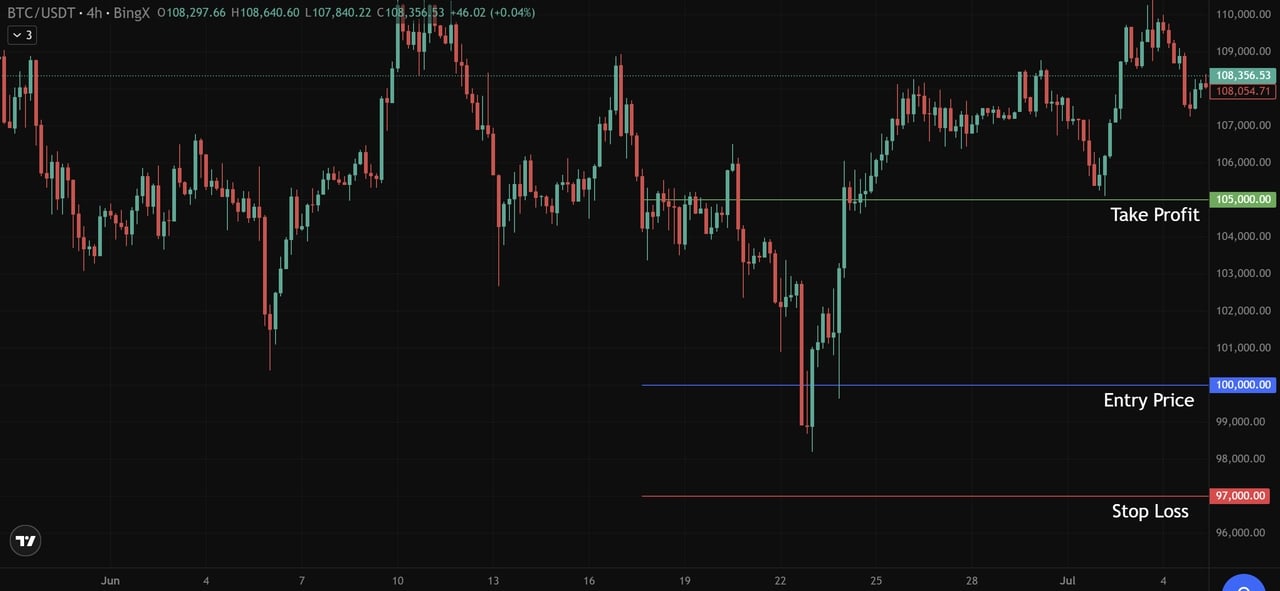In crypto trading, managing risk is not just a skill; it’s survival. Unlike traditional markets, digital assets can fluctuate by double digits in a single day, amplifying both opportunity and danger. This volatility attracts traders, but without a plan, it also leads to quick losses.
That’s why professional traders on BingX treat risk management as the foundation of every strategy, not an afterthought. Tools like
Stop-Loss, Take-Profit, and
Copy Trading help them control exposure and preserve capital while staying active in fast-moving markets.
In this guide, we’ll cover seven practical rules that every trader should know to manage risk effectively and trade crypto with confidence.
What Is Risk Management in Crypto Trading?
Risk management in crypto trading means protecting your capital by controlling how much you expose to the market and defining when to exit a position. It’s not about avoiding losses; every trader experiences them, but it's about keeping those losses small enough to recover from.
On BingX, this principle applies across both
Spot and Futures trading, where high volatility and leverage can quickly magnify gains or wipe out an account. A disciplined trader sets predefined loss limits before entering a trade, using tools like Stop-Loss orders and margin controls to prevent emotional decisions.
Whether you’re long on Bitcoin or scalping altcoins, risk management ensures that no single position can damage your overall portfolio, allowing you to trade strategically instead of reactively.
Rule 1: Never Risk More Than You Can Afford to Lose
The first rule of trading is simple: protect your capital.
Every professional trader limits risk per trade to a small fraction of their account, typically 1–2%. This ensures that even a series of losing trades doesn’t cripple the portfolio. For instance, with a $1,000 account, risking $20 per trade keeps potential losses manageable and gives you room to recover. This approach creates consistency and reduces emotional pressure when markets move sharply.
On BingX, traders can use the
Margin Calculator before opening a position to estimate how much they stand to lose or gain at different leverage levels. This helps align trade size with acceptable risk.
The goal is to survive volatility long enough to benefit from it, not to overexpose yourself in a single position. Small, controlled risks are what keep traders in the game when others get wiped out.
Rule 2: Use Stop-Loss and Take-Profit Orders
Successful traders don’t rely on luck; they rely on automation.
Stop-Loss and Take-Profit orders are essential for controlling risk and locking in gains without constant monitoring. A Stop-Loss automatically closes a trade when the price reaches a certain level, preventing small losses from becoming large ones. Meanwhile, a Take-Profit secures profits when the market hits your target, ensuring you exit before sentiment reverses.
For example, if you enter a
BTC/USDT long at $100,000, you might place a Stop-Loss at $97,000 and a Take-Profit at $105,000. This structure defines your potential loss and gain before the trade even begins.
BTC/USD Price Chart (Take Profit & Stop Loss) - Source: Tradingview
The most important rule is discipline; never move your stop further away in the hope of a rebound. A fixed plan protects your account; emotion rarely does.
Rule 3: Apply the Risk-to-Reward Ratio
A solid risk-to-reward ratio (R:R) ensures that potential profit justifies every risk you take. Most professional traders aim for at least 1:2, meaning they risk $1 to make $2. This balance allows them to stay profitable even if only half their trades succeed.
For example, if you risk $50 with a target gain of $100, your expected value remains positive over time, even with a few losses. This ratio transforms trading from guesswork into a calculated strategy.
On BingX, advanced charting tools let traders visually map their stop-loss and take-profit levels before confirming an order. Seeing the ratio on-screen makes it easier to plan trades logically rather than emotionally, keeping risk under control and profits consistent.
Rule 4: Diversify and Avoid Over-Leverage
Diversification is the foundation of smart risk management. Instead of concentrating capital on a single coin or trade, spread it across multiple assets and strategies. This way, a loss in one position can be offset by gains in another. For example, you might allocate part of your funds to Spot trading for stability, use BingX Futures for short-term opportunities, and explore Copy Trading to mirror experienced traders.
Equally important is avoiding excessive leverage.
Using 50× or 100×
leverage can amplify profits, but it also magnifies losses and can trigger liquidation within seconds of a small price swing.
On BingX, traders are encouraged to keep leverage moderate and position sizes proportional to account value. Remember, leverage is a tool, not a shortcut. Responsible diversification combined with controlled leverage allows traders to stay in the market longer and manage volatility more effectively.
Rule 5: Plan Each Trade and Stick to It
Behind every consistent trader is a clear plan. Before placing any order, define your entry, stop-loss, take-profit, position size, and the reasoning behind the trade. This checklist keeps decisions grounded in logic rather than emotion.
For example, if you plan to buy
ETH/USDT at $3,000 with a stop-loss at $2,940 and a take-profit at $3,150, you’ve already outlined your risk-to-reward before execution. If the market doesn’t behave as expected, you exit without hesitation.
Keep a trading journal, either in your BingX notes or a spreadsheet, to record results and reflections. Over time, you’ll see which setups perform best. The key isn’t to win every trade, but to stay consistent with your strategy.
Rule 6: Control Emotions and Avoid Revenge Trading
Emotions can turn a good trader into a gambler. After a loss, it’s tempting to double your position or chase the market to recover quickly, a reaction called revenge trading. Instead of cutting losses, traders often dig a deeper hole.
Imagine losing 3% of your account on a BTC/USDT short, then immediately opening a larger trade hoping to “win it back.” If the next move goes wrong, that small loss can snowball into a 15% drawdown.
The smart approach is to step back and reset. Set daily loss limits, take breaks when frustration builds, and focus on data, not emotion.
On BingX, beginners can study
Copy Trading strategies from seasoned traders to observe how disciplined risk control prevents panic decisions. Trading psychology isn’t about avoiding emotion; it’s about mastering it before it masters you.
Rule 7: Keep Learning and Adjusting Strategies
The best traders treat risk management as a skill that’s always evolving. Market dynamics, volatility, and sentiment change constantly, which means your strategies should too. Regularly review your trading history, identify what worked, and refine your approach through back-testing and data analysis.
BingX Academy offers in-depth guides, tutorials, and market insights to help traders stay updated with new techniques and tools. Beginners can also use BingX demo trading to practice strategies in real market conditions without risking capital.
The key is consistency, keep learning, adapting, and testing. Even small improvements in execution or timing can make a big difference over the long run.
What Are the Most Common Mistakes in Risk Management?
Even experienced traders can undermine their strategy by repeating preventable mistakes. The most frequent ones include:
• Over-leveraging: Using excessive leverage amplifies both gains and losses, leading to rapid liquidations.
• Ignoring stop-loss orders: Skipping or moving stops exposes your account to uncontrollable drawdowns.
• Trading too often without a plan: Impulsive entries erode consistency and cloud judgment.
• Risking entire capital on hype coins: Chasing trends without analysis often ends in steep losses.
• Neglecting performance tracking: Failing to monitor your win/loss ratio or risk-to-reward consistency hides weaknesses in your system.
Even the most accurate analysis fails without risk discipline. Long-term success depends on managing exposure, staying patient, and treating every trade as part of a structured plan.
Conclusion
Mastering risk management is what separates traders who survive from those who burn out. Crypto markets move fast, and no amount of analysis can replace disciplined control over exposure, leverage, and emotion.
By following these seven rules, limiting losses, using stop-losses, maintaining a solid risk-to-reward ratio, and planning every trade, you build consistency and confidence over time.
Remember, success in trading isn’t about predicting every move but protecting capital so you can stay in the game. Smart risk management keeps you prepared for every opportunity the market offers.
Related Articles
FAQs on Risk Management in Crypto Trading
1. What is risk management in crypto trading?
Risk management means controlling how much of your capital you expose to each trade and setting clear exit levels. It’s about minimizing losses, not avoiding them entirely.
2. Why is risk management more important in crypto?
Crypto markets move faster and with greater volatility than traditional assets. Without a plan, even small mistakes can lead to major losses within minutes.
3. How can BingX help manage trading risk?
BingX offers built-in Stop-Loss, Take-Profit, Margin Calculator, and Copy Trading tools to help traders define risk levels, automate exits, and follow disciplined professionals.
4. What is the ideal risk-to-reward ratio in crypto trading?
Most experienced traders aim for a 1:2 or better ratio, risking $1 to make $2. This allows consistent growth even if only half of the trades are profitable.
5. What are the most common risk management mistakes?
Frequent errors include over-leveraging, ignoring stop-losses, trading emotionally, chasing hype coins, and failing to track performance or risk-to-reward consistency.



